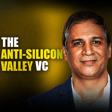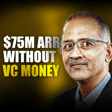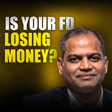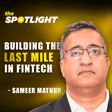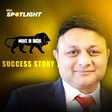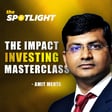Become a Creator today!Start creating today - Share your story with the world!
Start for free
00:00:00
00:00:01

Powering EVs for the e-rickshaw economy | Varun Goenka @ Chargeup
The e-rickshaw industry is experiencing rapid growth, and a critical requirement is a reliable battery-swapping infrastructure. Varun talks about the large opportunity in battery swapping, using smart tech to build an asset-light multi-location chain of charging points and how they are enabling entrepreneurship as a part of their business model.
For more such interesting founder journeys, subscribe to www.founderthesis.com
Transcript
Introduction to ChargUp and E-Rickshaw Connectivity
00:00:00
Speaker
I'm Varun Goenka, founder and CEO of Chargup.
00:00:15
Speaker
I'm sure you would have seen the small e-rickshaws outside metro stations. The kind that will drop you to your home. You may be surprised to know, but for last-mile connectivity, these e-rickshaws are one of the most pervasive forms of transportation. The thing about this booming e-rickshaw economy is that it needs a robust battery swapping infrastructure.
00:00:34
Speaker
because these rickshaws are frequently driven by migrant workers who don't have access to charging infra. ChargeUp is a startup, chasing this massive opportunity and in this episode, your host Akshay Dutt speaks to Varun Goinkar, the founder of ChargeUp. Varun talks about the large opportunity in battery swapping and how they have used smart tech to build an asset-like multi-location chain for charging points and how they are enabling entrepreneurs as a part of their business model.
Varun's Early Ventures in Renewable Energy
00:01:00
Speaker
Stay tuned and subscribe to The Founder Thesis Podcast and any audio streaming app to learn how to spot opportunities and build a business smartly using tech.
00:01:17
Speaker
I got to learn about this, you know, the power sector, the energy sector during that time, clean energy and all. And 2010-11, there was a new regulation by the Government of India on green trading of green certificates, similar to carbon credits.
00:01:32
Speaker
And that something drew my interest and in 2011, I started my first company focused on this specific segment. We became the member of Power Exchange and that is where I took the initial funding from a relative in Delhi to him as an investor in that company and started that company.
00:01:51
Speaker
So this green certificate is like a tradable certificate, like it has some monetary value and you can, companies can get themselves certified and earn green certificates and those certificates can be a revenue source for that company. So how does a company earn green certificate?
00:02:07
Speaker
So basically, there's a regulation. People who are generating power on electricity on renewable ways will be issued green certificates as an incentive. And people who are consuming power on conventional sources need to buy these certificates as an obligation.
Pivot to Solar Projects and Oil Industry Success
00:02:25
Speaker
And there was a marketplace, there was a power exchange on which we used to create these certificates. OK. So renewable energy means like solar, wind,
00:02:34
Speaker
Absolutely. Solar, wind, hydro. Okay. Okay. So you would help these companies to comply with the norms, take care of documentation, help. It's like a consulting. In that consulting, consulting, trading of these certificates.
00:02:47
Speaker
And what was your monetization? You would keep a percentage of revenue that they earn from it? Yes, we used to have a revenue share with them. It's a win-win for them. They don't have to invest anything upfront. I mean, they will pay you only when they are earning money, so it doesn't hurt them. So how big was this business? What kind of earning potential did it have? Tell me a bit about that journey of growing it up.
00:03:11
Speaker
That was a very journey like a heartbeat because there are too many ups and downs. When we started, we did a superb revenue. We did around 11 CR of top line and a very good bottom line into that business. But here top line is defined as what? Like the total, like the gross or your share of revenue?
00:03:33
Speaker
No, the top line is the value we have traded. That's like a GMV basically. And the first year was absolutely brilliant. We were on the cloud nine and second year the market crashed and we were burning money on that. Because of certain gap from the government policy side, there were too many sellers who came on board. There were not much buyers who were complying to the obligation.
00:03:58
Speaker
Okay, okay, okay. The norms to comply were not strong enough, so not everybody was. So that crash made us think through and look through to pivot from trading to other sources and that's where we landed up into solar. We started doing complete turnkey solar projects. What does that mean, doing a turnkey solar project? Like somebody who wants
00:04:22
Speaker
So, solar is like the someone is manufacturing panel, someone is manufacturing inverter, someone manufacturing battery. So, we come in as a system integrator where we say we will design the project for you, we will source this, install this, maintain this for you. But you know Akshay, even that was something where we were not ready to do things in a conventional manner. So, we first identified the industry, oil industry, that was all petrol pumps.
00:04:48
Speaker
We made a new norm. We made a standard product, a standard solar kits. So it was like a commodity, what we created. And all these petrol bomb owners could just see what suits their requirement. They could buy the product. And it went off so well that we became one of the largest suppliers of these kits to Indian oil.
Inspiration Behind ChargUp and Industry Exploration
00:05:08
Speaker
We designed it for SR, we designed it for BPCL. So we became synonymous with solar for oil industry. It was Atlanta energy.
00:05:16
Speaker
Wow. And it's an interesting name at Lambda Energy. Why did you choose this name? Easy to remember. People used to call that simple and easy. And what was the way in which you were selling it? Was it a one-time cost or was it like you were selling electricity per kilowatt hour? No, we were one time. It was not a recurring thing. We were selling the whole project. They were buying the whole project at one single cost.
00:05:42
Speaker
And then they would pay you some AMC for maintenance. And how did that business do? What kind of revenues did you see there? How did that get? The business grew really well. We did exceptionally good. But over years, what happened? Firstly, while doing this business, we missed the bus of the larger projects, which was happening in selling electricity in solar, the Resco model. Because we didn't have the understanding and knowledge at that point of time, how that operates.
00:06:07
Speaker
also the business we were into it after certain time it became too much crowded since there was not much entry barrier into it and it became more of a brick and mortar business. That's where you know we kind of reduced the whole volume and started focusing on only specific products in government sector and by that time my family they also stepped in they started looking into that business and charge up happened and then I stepped out
00:06:33
Speaker
from that. Okay, so how did Chajav have to tell me about that? Yeah, so that's also very interesting. You know, there was no such plan to come into EV, in fact, okay, I used to stay in central Delhi, and they used to see a lot of those e-Rishas that took books. And that was the lifeline for all the last mile connectivity. So during one of my ride, while I was going from Patel Nagar to Karnad place, the Rishas stopped in between, I had to change the vehicle because the battery has drained out completely.
Battery as a Service Model for E-Rickshaws
00:07:02
Speaker
That made me research through it, think through it and find out what is it, why the industry is facing and how large is industry. And at the same time, I met someone from my old solar days colleague who kind of connected me with, you know, my co-founder who was also working into the similar E-Rixia battery thing. And he thought that since I have been synonymous with patrol bomb, he's looking at EV, these two could have a match. And that is where we connected on the same
00:07:29
Speaker
problem area and we started our research together for 8-9 months into this. Was this a big opportunity? Just to give you an answer to the numbers, 2018 when we started doing this, there was 2 million E-Rishas in India on road, which was more than the total EV sold in China. It's more spread towards the concentration, more towards northern belt and towards eastern belt of it.
00:07:54
Speaker
So this is like a last-mile solution, but it is not like a covered auto, right? It has that, like that. Yes. Like a cycle rickshaw, except that it's like battery powered and with a small motor. I mean, it outstates a cusp between the cycle and the auto. What did you see as the opportunity there? Like what was the existing way in which these e-rickshaws were managing their charging? What did you see that the opportunity lies in?
00:08:18
Speaker
Firstly, that time we didn't have any such vision. We just saw that there is an industry which is very large. Secondly, there is a huge pain area. They buy these batteries which has to be replaced every six to eight months. They have to charge it for 10 hours a day and there was enough demand in the industry but they could only cater 50% of that because of this range anxiety and this capital instrument.
00:08:42
Speaker
Pain area was very high for this. Second thought across globe in any EV industry, you'll see there's a chicken and egg situation, vehicle first or infra first. Here already we had 2 million vehicles, so that was solved. And we also were very clear on this one conceptually that today when we buy any normal petrol or diesel vehicle, we don't buy the fuel for three years, we just buy the vehicle.
00:09:05
Speaker
So why it's for EV? Buy the vehicle, not the fuel for
Technological Innovations at ChargUp
00:09:08
Speaker
three years. All these things combined, we said, OK, battery as a service, battery swapping, actually, is the solution for them. Paper use, no strings attached. The drivers, if we can impact their lives, if they can run more, they can earn more. That's what as Charger would like to do. OK, got it. So is there a standard battery across all eRixals or like each brand has their own format and
00:09:32
Speaker
So, when we talk about the three-wheeler industry, we could standardize it up to a certain extent. Interestingly, three-wheelers have large mechanical boxes at the standard electrical platform. So, the batteries which we introduced, the advanced lithium batteries, these are lightweight plug-and-play could fit in any vehicle.
00:09:50
Speaker
Okay. Okay. So irrespective of the manufacturer, you were able to design a battery that would work in any Erixra. Okay. Amazing. Okay. Tell me something. So you said that the demand was only 50% met. This you're talking of the demand for Erixra as a last-mile mobility solution.
00:10:08
Speaker
Absolutely. These rishas are actually carrying almost 60-70 million people every day. So, there was enough demand. The problem was because of the battery issue, they could not do much. Prior to charging, they were running only 70-80 kms per day earning around 850 rupees. With charger, what we triggered for them was now they are doing 140 kms earning 1800 rupees a day.
00:10:34
Speaker
So there's a new shift and from 10 hours charging to a two-minute auction and very few businesses are able to give you such opportunity where other than the market opportunity, you are able to impact the lives of the people at the bottom of per hour and in a cleaner way. Are there as many regulations for each as compared to the three-wheeler auto rickshaw? No, it's not that regulated. Okay, like for a three-wheeler auto rickshaw, you need a license and they are limited licenses and
00:11:00
Speaker
Being an electric vehicle, these are exempted from majority of this RTO lies a lot of times.
00:11:08
Speaker
Oh, wow. Okay. I believe for auto is the way it operates is most people who are driving, they take that on a daily rent or something like that. How does it happen in E-Rickshaws? So in auto also, there is a, both the kind of thing exists, drivers who own the vehicle and drivers who run all rent. Same thing happens in E-Rickshaws also, but in E-Rickshaws, 71% of the population is driver owned vehicles. So the one because the cost is lower.
00:11:34
Speaker
Okay, so tell me that the zero to one journey when you thought of it and then how did you launch it? You must have tried different things before you finally found success in one model. What were those experiments you did along the way before you found success? And I just want to go through that journey with you.
00:11:50
Speaker
Actually, there were a lot of puzzle pieces which we had to solve for this where it started with our first station deployment, which area we need to deploy it from there to getting the first set of drivers to, you know, because there was no benchmarking, there was no precedence to experience this. So I think, you know, the first one month we had to really devote time into getting the first set of drivers on a platform.
00:12:13
Speaker
for which we had to try different ways of marketing,
Franchise Model and Network Expansion
00:12:17
Speaker
incentivizing. But even before that, you would have had to figure out the battery, right, to create a compatible battery that works across and how to manufacture it or how to procure it. How did you do all of that?
00:12:29
Speaker
So that was something we did before starting the company. While we were doing our research, my co-founder was already, he had worked out a battery design and product. So that's something we zeroed on before starting the business because I come from energy storage background. And I knew that your entire business, that trust of the consumer and the whole unit economics is dependent on the battery technology. So that needs to be sorted first. If that's not sorted, you can't start this business.
00:12:57
Speaker
And how did you procure them? Were they made to order? Were you able to buy them off the shelf? Did you import them? Those are also very new batteries. So we initially procured them to start our product market site and pay for that. And procuring the first set of batteries, our first challenge was to get the drivers on board.
00:13:18
Speaker
But even procuring the batteries would have been a little challenging, right? To find the right vendor, to do the quality testing and there must have been minimum order quantity. I think that's the thing what Maravari Vanayaga do before starting a business. He first saw the most challenging thing. So my co-founder's parent company was already into that line of business. So they could make suppliers the most reliable battery technology.
00:13:45
Speaker
Okay, interesting. Which company is that? Like, is it a brand I would have heard of? It's like a green fuel energy solutions. They are primarily into CNG components. Okay. They would be like already importing batteries from China and supplying to various OEMs and all more. So interestingly, they have done their own designing or their own patent on the design of the battery. And they were making the most premium batteries till date in India.
00:14:14
Speaker
They are manufacturing in India. These are built for EVs only, the batteries that they are manufacturing. Yeah, absolutely. These are specifically for EVs, two and three wheel industry. Which location did you decide to start your pilot with? East Delhi. So tell me about getting that adoption. What did you offer to a driver? What was the package? What was the product? What was the pricing?
00:14:37
Speaker
We onboarded our driver who was like another leader in that area as an influencer and we subsidised his pricing on Perswap and we advised him on getting you know attaching more drivers so at least for you know the first three months that is how we got that build that trust among the driver community and you know what was the pricing like what were you selling the price of time we were doing 150 rupees for a single swap
00:15:04
Speaker
And there was some deposit? Yes, we do take certain deposits initially. Because you're giving them one battery, which they are walking away with. So you need to have some security. That deposit is just a fraction of the battery cost. It's more about the mindset that they have some money deposited with us. That's it. It doesn't cover anything on the battery side. Skin in the game, basically.
00:15:29
Speaker
That risk initially we had to take because there was a lot of myth around it, the drivers will take up with the battery, they won't return. Even that time our tech ID infra was not completely settled or implemented. That risk we had to take that out of time. And that's an interesting find out for us that the drivers never stole the batteries because they were able to earn from it. Not a single incident in last three and a half years. Wow, amazing. Okay.
00:15:58
Speaker
So for a driver, the pitch was that this is a superior battery. It will give you more range and pay 150 rupees to swap it in two minutes instead of charging for 10 hours. It will make you more productive.
00:16:12
Speaker
So Akshay, all this pitch didn't work differently. The simple thing was, you have your existing battery, don't sell it, keep it at home, start owning this one. You are already your cost of charging and amortization cost of battery is 200. I'm giving this in 150. Do a trial.
00:16:30
Speaker
If you like it, use it. Over time, there are some drivers who came and started telling us, the battery is almost 100 kgs lighter. So I can easily now go to the steep, steep roads. My vehicle performance is getting better. At Charger, you have committed 80 km, I am getting 100 km in a single. So that is where the word of mouth and that trust started building up.
00:16:53
Speaker
So, what was the role of tech here? Like you said your tech was not ready yet. What did you see as the role of technology in this?
00:17:01
Speaker
See, at the initial stage, the tech's role was more towards the asset securitization, was giving a safe and reliable right to the user. See, I mean, these batteries are dumb in nature. It's the IT tech which makes them smart. So we install an IoT telematics within every battery, which gives us the driver data, the geolocations, which also tells about the behavior of the battery and the behavior of the driver, which helps us in preventive maintenance for the batteries as well.
00:17:26
Speaker
How does driver behaviour affect battery performance? A lot. His driving patterns, how many times he is using a brake, whatever rash driving he is doing, what is the average kilometres he is doing. How many times he is standing idle by switching on the vehicle. So what of this car? And it's not a battery but also the driver patterns. What are his routes from where he is detouring for a swap. So we need to plot another station in this location. What time of, how are his performance during weekdays and weekends? What are his peak hours?
Impact of COVID-19 and Strategic Growth
00:17:54
Speaker
So a lot of data about the driver.
00:17:55
Speaker
So this was like a SIM enabled battery which was able to send data back to you real time about the GPS coordinates and probably the charge level. So were you able to also do like send a notification to a driver your battery will get over in 10 kilometers and stuff like that.
00:18:15
Speaker
Initially it is not. Now with the driver app, the drivers will get automated notifications on how much kilometers is left, where is the nearest swap station, where you need to swap it. Okay, interesting. So from that one charging point you started and what was that one charging point you started? What did it look like? Was it like a shop where you had batteries stored on racks and you would swap them?
00:18:41
Speaker
Yeah, it was a very Indianized desi simple store where we had the swapping cabinets that used to charge the batteries. The driver used to come that they didn't need any assistance. They could just plug out and do the swapping and back on roads. So it's just two minutes and they're back on road. It was cell service, like they could pick up a battery of their own. So it was a cell service. But yeah, it was more, you know, it was not an unmanned station. It was a manned station.
00:19:08
Speaker
Yeah, because for payment, you need somebody there. Payment is there and still I think in India, today we as individuals, we have not graduated to fill the petrol designer cars on our own. I want the same with these drivers. I want them to be hampered that way. Okay. So, and how much did that station start earning you? The first station, charging station? It started earning in the first quarter of operations, I think around 50, 60,000 per month that started.
00:19:36
Speaker
generating revenue. We started for the first, in fact, we started in 2019, and then there was COVID. But still, we were clear that until and unless we solve all the pieces from battery to IT to the financial model and business model, we are not going to expand our network. And interestingly, Akshay, in the first year of operations, we were part of one Thai Delhi CNBC Young Tugs program, where we bought a half a million check investment.
00:20:03
Speaker
This was like a shark tank kind of an event. But we didn't took that money at that point of time. Oh, you didn't? Okay. Why is that? The business model was not ready. Number one. Number two, we learned it. When you're getting money, you should take it. What do you mean the business model was not ready? What was the gap in it? And how did you fix it? So during the initial months, we were figuring out
00:20:26
Speaker
the customer behavior, what are their preferences, what are their non-negotiables, what will make them stick to this solution and how far the solution can go. You know, there are a lot of questions around swapping versus charging or why they should not. Well, those are things we are trying to figure out in that. What we understood that number one, for two and three wheeler industry, especially commercial segment, this is the only solution which is going to work.
00:20:49
Speaker
And two, why do you feel that way? See, with swapping in the commercial segment when you do, firstly, you reduce the cost of asset by 40%. You're removing the battery from the vehicle. The cost of ownership reduces by 40%. Secondly, you know, in commercial sector, you can't afford a downtime.
00:21:07
Speaker
In EVs, 90% downtime is because of batteries. So we are removing that downtime issue. And lastly, we are enabling, we are giving the drivers free to run more and earn more. They can go beyond their existing geography of 10, 15 kilometers. And today, they are doing outside that geography of North Delhi or Gurgaon, Noida, and expanding. OK. Got it. OK. And OK. So you said first was this part of the puzzle of swapping versus charging. What else was there in the business model?
00:21:36
Speaker
So understanding the customer behavior, now we need to figure out what type of network we need to build. After we launched our first service battery, the service from a single location, we just solved the capital problem for them and the charging problem. But the range anxiety still existed because for a swap, they had to come back to the base location. That's why we decided we have to be in every pin code. And the driver should not even take a user for a swap. It should be on his way. Now to build that, what type of dealership models has to be there?
00:22:05
Speaker
how we can scan it faster. So we worked out an asset light model where we don't buy the batteries we procure them on lease. We worked out a dealership model where we'll be utilizing a small space of these small SMEs into battery business, automobile resource. So from where there's a more visibility for the driver and he can swap at any location. So in a way, we became the 7-11 of that industry. We are on every side of the road. A driver doesn't even need a tech to figure out where the charger is.
00:22:34
Speaker
What is, so in this franchising model where you appoint dealers who do this, so how much space does it need from them? Minimal 50 square feet. Okay. And you would have some sort of branding also that you would give them so that it's recognizable.
00:22:51
Speaker
Okay. Vocability to charge up branding is what we have to do for sure. But interesting for this dealer community, this was something of a lucrative offer, but it took us really good time for us to crack that dealership thing. So for a dealer, there is no working capital required, no marketing, no maintenance. And from this existing place, existing manpower, he can just do this business and earning the highest returns.
00:23:13
Speaker
What kind of returns? Like 150 rupees per swap is what you are charging. We pay him some commission per swap and the dealer recovers his investment in six months. What does he need to invest? So he invests some money into the charging infrastructure, the swapping cabinet, that is what his investments come.
00:23:35
Speaker
So what are the economics then for like for every dealership which gets set up, how much do you earn? How much does the dealer earn on a monthly basis? See for a dealer, as I said, the investment he makes, he covers that in six months time. So he's investing some of 70 to 80 grand.
00:23:51
Speaker
and he calls that in six months time. For charge up, we are unit positive from first month because as we are taking these batteries on lease and we are furthering away selling them on the subscription model. Well, you know there's a gap between the lease cost and the subscription model. Revenue starts increasing substantially because the lease is fixed whereas the revenue keeps on increasing as the asset utilization, asset rotation keeps on increasing.
Expansion into EV Financing and Partnerships
00:24:15
Speaker
Okay, got it. So, for example, you might be paying, let's say, 5000 rupees monthly lease on a battery. Now, if that battery is getting turned around twice in a day, so that's 300 rupees per day in 30 days, so that is what you earn from it. But if it is lower utilization, if it's getting turned around once a day, then so it depends on that, basically, how frequently that battery is getting turned around.
00:24:40
Speaker
That's what our capabilities are that how we can actually efficiently rotate or utilize the asset. So how do you bring in efficiencies? Well, they're different ways in terms of the, you know, we understand the peak hours of peak hours, our prices are designed accordingly, we can trigger the driver behavior with that. So there's a simple metric, what do people look at batteries to driver ratio, how many batteries to be deployed per driver. So today, we can say that we are the most efficient in that our batteries per driver.
00:25:10
Speaker
What is that ratio for you? So for industry, the standard is 2 is to 1. One in the vehicle is 1.5. For us it is 1.5. And the way you appoint dealers is also based on the data, the telematics data you are getting from the driver, which shows you what location they are traveling. So you will appoint dealers along that route. And that's how you've been expanding also.
00:25:33
Speaker
Right. Okay. Okay. Okay. Interesting. So when did you do your first fundraiser? Like by the time COVID hit, you had not done any fundraise, right? No, we didn't. In fact, we did our first raise last year, December. We did. Okay. Okay. So like during COVID, you must have got impacted as well, right? Because like even last mile would have dropped because commute to office would have dropped.
00:25:59
Speaker
So interestingly, the business didn't got affected so badly, Covid, because last while connectivity, as I said, was a lifeline. And after Covid, the movement was happening. Even during the second lockdown, the charger was completely operational for people to travel from metro to hospitals and everywhere. Since we were, our customer base was all driver-owned vehicles. That's why our business was not impacted. People who were working with the rented fleet operators who went back home, their business was not impacted.
00:26:28
Speaker
So by the time you raised your first round, and I think you told me you raised your first round in 2021. So by that time, what was the size of the network? How many charge points did you have? What were the number of drivers?
00:26:43
Speaker
So that's what we have for some 70 to 80 stations we had in Delhi. And on an average each station would be earning about 50,000, 60,000 per month kind of a revenue. So what was the fundraise for? It was for going beyond Delhi for
00:26:59
Speaker
So to the growth capital, we were still focused on Delhi NCR, apparently, but to expand the network faster, spending was more towards the growth side, marketing and expansion of it. Okay. So what is the number now? Like how many charge points are up now? What is the number of drivers? So we are not 200 plus stations, swap stations, where we have 2000 drivers on our platform doing one lakh swaps per month.
00:27:28
Speaker
And you raised 7 million round just now. So this round is again to scale up further. So this is for expanding to the next 10 cities and scaling this number from 2,000 to 50,000 drivers on our platform.
00:27:48
Speaker
Now, in fact, now we have evolved more into a fine tech platform, what we say. You see, the target audience is the two wheel and three wheel industry, all this, the delivery segment and the people who are transporting goods and passengers.
00:28:00
Speaker
For them, demand has never been a problem. It's been more of a simple and productive life. So Charger's mission is to power the growth of these million drivers. As a fine tech platform, the finance network and tech, the first thing that we built up was a network, a deep distribution network, which built up the brand and the trust among the community, gave us a lot of data points, understood how the energy management needs to be done.
00:28:21
Speaker
From there, we have evolved into a company where we are also now helping into financing of vehicles. So we have onboarded with the top vehicle manufacturers, top NBSCs of India, who are selling and financing the vehicles through Charger Network, where we have restructured the whole value chain, reduced the interest cost, reduced the down payment for the drivers. So it's like easy adoption of EVs for them.
00:28:45
Speaker
Okay, so like the charger points are also point of sale for EVs now or like how you doing the financing or somebody can come and say I want a loan and he will get a loan approval and that he will take to an EV point of sale and buy the EV from them.
00:29:02
Speaker
Oh, okay. For the driver, there's a single point. To showcase this whole model, two months back, we did a EV mela, like a big billionaire sale. So two days, Central Delhi, 1000 drivers visited. They took the demo of the vehicle. There were four different vehicle manufacturers standing with the vehicle. They chose the vehicle, came to the financing counter with the biometric within one minute, their symbol was cleared. Next was charge up counter, they gave the deposit money, they gave the documents.
00:29:29
Speaker
or the vehicle. From there, there was a counter of Zomato, Rapido, Uber, where they could choose with whom they need to work. EV adoption to employment, a complete solution. Amazing. Okay. Okay. So you are now not just doing the e-ricks, but also two-wheelers which are used for food delivery. Absolutely. Yeah. Okay. Okay.
00:29:50
Speaker
So, these two-wheelers for food delivery, are they like branded? Like say you have Activa as an EV, but I don't know if it gets used for food delivery, but who are the companies which make two-wheelers which are used for food delivery? A lot. You know, interesting, India has more than 400 registered manufacturers of two and three-wheelers. And two-wheeler, if you say, starting from hero electric to hero motors, Okinawa, Aethar, a lot of companies introduced.
00:30:15
Speaker
So your network now has like, what is the split? Are they still majority e-rickshaws or is it more two-wheelers?
00:30:24
Speaker
So currently the majority is easier. Two-wheelers is slowly, suddenly carving out its path into this. They're increasing the shares over time. I'm guessing two-wheeler would be much bigger in the long term, right? Simply because there are more two-wheelers on the road. Absolutely. This is a pretty good ecosystem which you have built of helping someone get employment directly. Like essentially you are enabling someone to become an entrepreneur within a day.
00:30:47
Speaker
See for us, adoption of EV should be like a mobile phone. That simple and easy. We are just removing all the complications from there and making it simple for them. And the financing, you don't take that on your balance sheet, you are just enabling the NBFCs. We are utilizing our data, we are utilizing our leveraging our network to make it more efficient.
00:31:09
Speaker
Okay. So for an NBFC, the risk is offset because they're getting telematics data from the battery because the battery is provided by you. So that gives them. Absolutely. And you know, if it is like gadget on wheels, you can immobilize them remotely. You can track them. So it's more under your umbrella.
00:31:28
Speaker
So this TV melon was like a one-time thing. How do you plan to make it like a regular thing where if I want to buy an EV, I just go to a charge-up point and buy an EV? But charge-up points are like tiny, right? How do you make it into? So we have different formats of charge-up points, which apart from a full-fledged station with a 300, 400 square feet, two different formats of sizes we have. OK, OK.
00:31:55
Speaker
So the bigger format charge-up points would also have some vehicles available there for display for test drives. Absolutely. It's like a proper dealership experience. You can come to a test drive and book a vehicle and take delivery of it and get a loan. So you're essentially also then becoming a point of sale. So then you have that second revenue stream opening up, which is through the sale because you would get that commission on every sale that happens.
00:32:25
Speaker
Trust me, there are multiple revenue streams from financing to sale to service. There are a lot of things. The only thing what we are doing is we are not a capital heavy business. We are not into the dealership model. It's a new age. You can look like an omni channel, a digital and a physical both.
00:32:40
Speaker
What do you mean you're not into a dealership part? Like you don't buy inventory. That's what we do. We don't buy inventories. We don't put a station for a specific brand of vehicle. It's like a platform where different mates of vehicles, they come on to sell their vehicle. Different finances come to finance it. We are providing them a digital and a physical setup where our mode is more towards the distribution networks, the tech, what we have. Okay. Okay.
00:33:07
Speaker
And probably people can order any brand, even if the vehicle is not there, there would be some way to order it and get delivery. Like you would have an online way to order and the person can take delivery from that charger point. Okay. Okay. So just help me understand the economics for a charger point now. So how much would be the earning through sale of vehicle? How much would be the earning through financing solution?
00:33:31
Speaker
Akshay, that's a little early to say because this is something we had just started once and we have tied up the various large food tech companies with vehicle OEMs and the numbers are good but to come to a precise number will take little time.
00:33:45
Speaker
Right. Right. But on an average, what's like the commission for an EV sale? It was complete differs from brand to brand, two to three-wheeler differs on that. We are still not the Amazon who can define the commission on our own. Right. Right. Right. Right. Okay. Okay. Okay. Interesting.
00:34:01
Speaker
And this would be a lot more profitable, like the commission on sale, because there's less cost for it. So we don't see it like that, frankly. We just see that previously we were spending money on every customer. There was a customer acquisition cost for us. Today, for every customer we acquire, we are earning money. And we have a whole life cycle of energy management for the customer.
00:34:21
Speaker
Yeah, essentially you are becoming the Indian oil, like a fuel station, which is also selling vehicles and what other sources of revenue are there you said about servicing. So like you're setting up servicing or?
00:34:34
Speaker
No, not servicing. So we may, as I said, it's a fine tech plan for, so the finance is one part, network is one part where we are, is a revenue generation. That tech is more of an enabler and a value creator to provide some convenience to the drivers. Like we have certain non-negotiables or we can say certain constants for the drivers. There should not be surprises for them. One is, you know, the cost of ownership on the pricing front.
00:34:56
Speaker
Second, 100% uptime for the driver. Third, there should not be any waiting time for the driver at any station. Or they should not really detour it. They have to detour for 3-4 km for a swap. These are the four things where we are maintaining, creating the value for the driver.
Mission Million and Driver Empowerment
00:35:12
Speaker
And in the end of that, now the revenue things, currently there are two streams, tomorrow there will be four different streams.
00:35:18
Speaker
What will those four streams be? There can be many. That can be from the data. There can be a lot of optimized services for the drivers. But there will be many, what we believe. OK. So when a driver buys a vehicle through Charger, they don't need to pay for the batteries, right? Because battery is there as a service for them.
00:35:38
Speaker
So then the cost of buying a vehicle also would come down for them quite a bit. That counts as a big cost. Yeah, battery is a big part of the cost. Okay, amazing, amazing. Okay. So what's the roadmap? Like, where do you see charge up after, let's say, like a five year roadmap? Five year roadmap, one million drivers on our platform, charge up, you can say next, in fact, in next two years, every food or parcel delivered at your place will be powered by charge up.
00:36:06
Speaker
Are there any other players also in battery swapping? There are a couple of few more players in the battery swapping. Like funded startups? Yeah, funded startups. Absolutely. Okay. So then what do you see as the differentiation between you and them? Firstly, it's the choices what each company makes in terms of the type of network to be built, the type of battery technology to be adopted. And every company chooses their own leadership area. Like some say I would be leader into eRisha community.
00:36:34
Speaker
Some say I will be the leader into this specific battery technology. We say we will be the area leaders, like whichever cities we are present, we will be the king in that city. So, geography leadership, what we say. That's one of the differentiations. See, it's a very initial day for the industry. Today in India, we have 3 million EVs and government is targeting the next 80 million. So, in a way, we have not even scratched the surface here.
00:36:59
Speaker
Secondly, I think the company doesn't need to be a huge differentiator or innovation. What the industry needs is certain constants, what we just explained for the drivers, as Indigo maintains for its liars in the airline industry. And is there interoperability between battery swapping companies? Like if I am a user of ChargeUp and I am near a battery swapping station of another company, then can I?
00:37:26
Speaker
No, you can't interoperate this between two different energy operators. Interoperability has a second, another meaning is interoperable between two vehicles. Like today our batteries, same batteries are used in two-wheelers and three-wheelers are the same. But between two different networks, you can't do that. But I could move from one network to another network by giving back the battery, taking my deposit and then
00:37:50
Speaker
Yes, you can. Absolutely. Okay. Okay. Interesting. Okay. So right now you have only one SKU of battery that one battery is like a one size fits all. Right. Okay. Okay. And do you see more SKUs being created or. Eventually, yes, it will be created as the markets and the government also brings certain standardizations, but yes, else will increase.
00:38:11
Speaker
and like what based on capacity like high capacity low capacity or like based on vehicle compatibility not not much in the capacity but more on the vehicle compatibility
00:38:22
Speaker
And how do you get drivers to go digital, like in terms of downloading your app and engaging with them through the app? How does that happen? Firstly, already the delivery tech companies have already converted a driver into smartphones. Because our app is not just a
00:38:44
Speaker
you know, a payment gateway, but it's a service where they get to know how much battery is charged, how much kilometers they can run, what can improve their average of kilometers, whereas India is a soft station. So there are lots of convenient things. So it's like app which they use on a daily basis.
00:38:58
Speaker
They can plan what time to buy because it would show them dynamic pricing and like what time to swap so that you're able to manage peak loads and okay, okay, okay. And what is your, so, you know, your first center, which you opened, you use an influencer to get more people to sign up. It's probably like a very loyal machine for you now of getting signups like onboarding drivers. So how do you do that now? What is your current way of your go to market?
00:39:26
Speaker
So we do a lot of media activities from free service camps and road shows and all. And frankly, now we have reached the stage, at least in those cities where we are present. We have a waiting list going on. So 5,000 drivers already submitted their documents and waiting for us to deploy more batteries or stations for them.
00:39:45
Speaker
Why a waiting list? Do you need to approve them? So this industry, demand is not a problem. What you need to solve is the supply chain. And the EV suddenly in last one year, the weight has increased. The demand has increased. And EVs, the supply chain is dependent on a lot of global fab. So there is a supply constraint. So we have to manage and see where to allocate the resources, where to allocate the batteries.
00:40:13
Speaker
Okay. What is the driver onboarding process? What documents do they need to submit?
00:40:18
Speaker
So that's the basic KYC documents, what they do, they do a simple agreement signing and a check deposit with us. And yeah, I think it's a 15 million process. Okay. And you need to do that to prevent your risk because you're giving them an asset. It's like a microfinance where you have to secure and you, and here you, at least you have a cap, do you know how much he's earning because his earning per kilometer is known that okay, he's earning 12, 13 rupees a kilometer. So if he's doing a hundred kilometers a day,
00:40:48
Speaker
The risk is a lot more predictable here because you have more data.
00:40:53
Speaker
So the reason why you don't take on your users is because if you take them on, then shortages will start happening. Like somebody needs to swap and there's no battery available for him. So that's why you're not taking on. That situation we can let that happen. So we maintain a certain ratio on the batteries to driver ratio. So what is the way to increase the supply then? How do you see that getting sold?
00:41:18
Speaker
See, it's just a time frame. If you see once in another year or so, the industry gets a little more stabilized. The demands are more predictable and already the production capacities are increasing globally. I think the supply chain is much more sorted in that scenario. Okay. Interesting. Got it. And how big are you as an organization? Like what's your headcount and what's the split between people? What do they do? So we are talking of 80 people.
00:41:44
Speaker
And of course, majority is towards the operational side. So we have a growth team, we have an off team, and then we have a planning and development team where we have the data team, the tech, marketing. Okay, cool. So any lessons that you'd like to share with aspiring founders? Anything you want to offer them as advice? So you'll be persistent, you'll find your way.
00:42:09
Speaker
So this is an updated conversation. What you heard so far was recorded a couple of months back. And I'm with Varun again to talk about Mission Million. Varun, what is Mission Million? Hi Akshay. So Mission Million is our mission to power million EV entrepreneurs in India.
00:42:28
Speaker
If you look at the whole demographic, today there are more than 50 million last mile drivers in India transporting the passengers to delivering of goods. And this is increasing month on month. What these guys are struggling with, these driver community, is that the ICE vehicles, the increasing fuel price, but the revenue is not increasing. So that's charge up. We are helping them to achieve three things in their life. One, increase their earnings.
00:42:59
Speaker
Second, reduce their cost of ownership. And third, make them credit worthy. They can access to credit for them, since they don't have any such civil score, they can get access to good financing solutions to upgrade their livelihood. All this we are doing in a sustainable way through our FindTech platform, Finance Network and Tech.
00:43:23
Speaker
where we are accumulating the supply and demand both for electric vehicles, two and three wheelers. So, we start with network of distribution, swapping, charging. We start addressing first the energy problem for the driver. From there, we started solving the
00:43:48
Speaker
adoption of electric vehicles so that they can easily buy an electric vehicle at a low cost of financing. And lastly, our tech is something which is helping the whole ecosystem from asset safety, asset security, and 100% uptime for the drivers. So our tech is something what we are building completely, an AI-ML engine of predictive algorithm.
00:44:18
Speaker
where we actually track the vehicle behavior, the driver behavior, and the battery behavior. And we can actually predict in advance that there is going to be any downtime in the vehicle or battery because of various reasons, the patterns. And we have created an underwriting mechanism for the technology and for the driver both.
00:44:45
Speaker
So that's something we call as a karma score for the driver based, you know, creating his civil score. How do you track vehicle? Because you have no control over vehicle. You only have control over the battery. So in electric vehicle, the battery is fitted with our IoT device. That's how we track vehicle and the driver.
00:45:07
Speaker
But you would only get the geo data. How fast is it moving? Much more than that. So if I talk about only from battery,
00:45:22
Speaker
We get 30 different data points. If I extend that to vehicle, about the driver. So the driver behavior is which routes he's taking, where he's standing idle, how much he's running, how much time he's using brakes, at what speed he's driving. So a lot of driving. How do you know when he's using brakes from the battery? How does the battery tell you that he's using brakes?
Future Plans for Expansion and Services
00:45:50
Speaker
So the battery is a smart battery with a BMS device and the vehicle also has a communication protocol, the vehicle and batteries speak to each other. Okay. Got it. Very interesting. So this Karma score, does it help the driver to get credit and loans? Like if you have a good Karma score, what does the Karma score do?
00:46:14
Speaker
Akshay, currently we are building this Karma score for the drivers. What we have till now achieved is we have been able to reduce their cost of finance by substantially 7 to 8 percent. That's because we are able to control the whole life cycle of the asset and driver here. But as we are building this Karma score today, an average driver is eligible for a loan of up to maximum 1.2 lakhs.
00:46:39
Speaker
What will make him eligible is something beyond three lakhs of loan. And interestingly, this community are situational defaulters, not intentional defaulters. So we are mitigating those situations, default reasons for these drivers. Okay. How do you reduce 78% on the cost of financing? So cost of financing refers to cost of financing when they buy a vehicle.
00:47:07
Speaker
And how do you reduce that by 700%? So we have restructured the whole construct of it with the NBSCs. See, NBSCs were charging somewhere between 30 to 24% to the right. Really, that's like unbelievably high. This is extremely profitable business to be in that.
00:47:30
Speaker
No, actually no, but it was not the fault of MBSC as well because they were limited by the issues of the default, which was majorly the situation arising out of the technology, the product. So we kind of stitched all these things together through our fine tech and we could bring efficiency in that to average driver who was earning 22,000 per month.
00:47:56
Speaker
at charge up today, he's earning 40,000 per month. Because there is no downtime. His battery is always charged. There is never a time when he has to wait for it to charge or anything like that. That's why. And this financing, lower cost of financing happens only when they buy the EV through your EV melas. Now they can buy it through our dealer network as well.
00:48:19
Speaker
Okay, the dealers also now sell EVs, like they have some inventory, they keep some inventory to show. Not really. We have made it much of frugal models, the dealers are satellite.
00:48:33
Speaker
Okay, so they have like a tablet where they can browse, the buyer can browse and select and... No, actually not. See, this industry doesn't work in that fashion. In fact, I don't think so. Automobile still there is a experience is required. So there's a central one. He goes for a demo, he takes the ride and then he reaches out to the sales point of the dealer to translate that.
00:48:56
Speaker
And it's not only financing of vehicle, there's also financing of batteries, which currently is not happening in India. So that's something we have been able to crack. And there are already existing almost three million, I would say, electric three-wheelers in India, where the struggle is for the battery. Like, even there is no resale value of the vehicle, because as the battery consumes 50% of the cost, no one is ready to buy a vehicle with a dead battery. So our solution solves that problem as well.
00:49:25
Speaker
So like someone who has a dead battery, they don't need to buy another battery. They can just rent on a daily basis. They can rent, they can get it financed as well. Okay. Okay. Okay. Right. Very interesting. Okay. And give me some idea of what kind of numbers you do currently. What does the economics of the business look like? You must be sharing some revenue with the franchisees and what revenue comes to you.
00:49:51
Speaker
Currently, we are present in seven cities with 350 stations across. We have a registered driver base of 4,000 drivers on our platform. Average franchisee who invested lakh rupees with us, he almost recovered that in six to seven months.
00:50:09
Speaker
Okay. And the source of monetization is the battery rent. Like you take a daily rent for the battery or like every time you swap a battery, there is some charge or like, how is it monetized? Just help me understand monetization. Sakhshir, there are three key sources of monetization. One is the energy.
00:50:34
Speaker
where the driver pays us, beats swapping, beats charging. That's one source. Second is the financing source. On all this financing, we have a financing spread over it, where we are from that. And thirdly is our tech, from which the service that you are giving, the OEMs and the NBFCs, they pay us a commission on that. So, we have three separate sources.
00:51:01
Speaker
Okay, wouldn't most OEMs have their own tech? Like, give me an example of an OEM deal. You can take it Arzo, you can take it Yathri. See, I'm talking about very focused on the L3 market, the Eriksha market. It's one of the largest market and most unorganized market. Right, right, right, right. Yeah, there are no big funded players in that market.
00:51:28
Speaker
Yeah, there are likes of Mahindra, but still that market is dominated by the regional players. Okay, so for these regional players, the smart part of their electric vehicle is powered by you. Absolutely. And that brings us to the end of this conversation. I want to ask you for a favor now. Did you like listening to this show? I'd love to hear your feedback about it. Do you have your own startup ideas? I'd love to hear them.
00:51:54
Speaker
Do you have questions for any of the guests that you heard about in the show? I'd love to get your questions and pass them on to the guests. Write to me at ad at the podium dot in. That's ad at T H E P O D I U M dot in.

